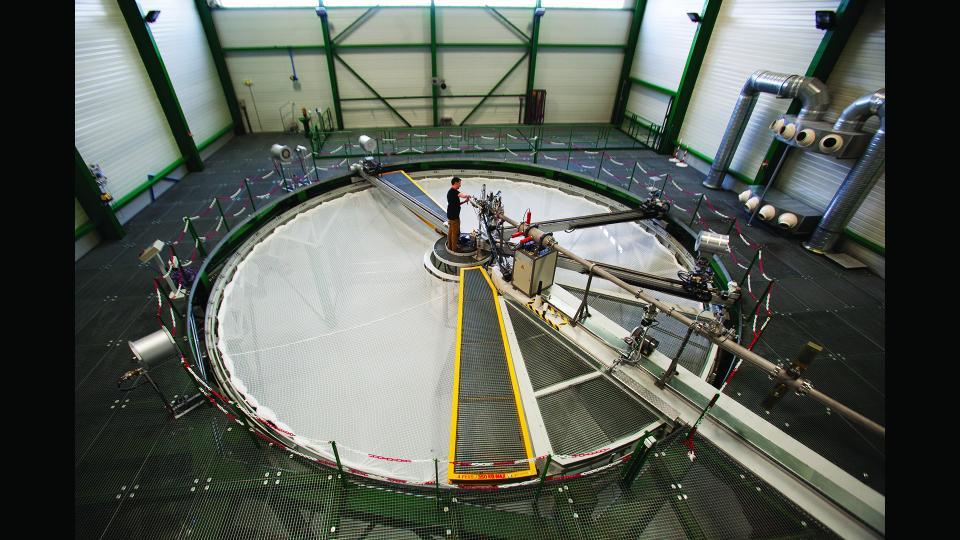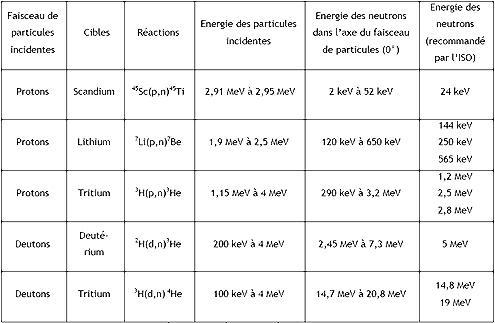Monoenergetic neutron fields AMANDE facility
The AMANDE facility (Accelerator for metrology and neutron applications in external dosimetry), commissioned in 2005, produces reference monoenergetic neutron fields for two purposes: neutron metrology related to fluence and dose equivalent, and testing and calibration of neutron detectors and dosimeters for several specific energies in a large range (between 2 keV and 20 MeV).
Background and purposes
AMANDE is run by the Microirradiation, Neutron Metrology and Dosimetry Laboratory (LMDN), which is part of IRSN's Dosimetry Research Service (SDOS). LMDN is associated with France's national testing laboratory (LNE), where it is known as LNE-IRSN. As such, it holds the national reference standards for neutron fluence (number of neutrons per unit area) and the derived dosimetric values such as dose equivalent.
In this context, LMDN develops and runs facilities producing reference neutron fields as defined in the standards ISO 8529 and ISO 12789 used to:
- calibrate radiation protection instruments (calibration in one or more types of defined neutron field),
- determine measuring instrument response as a function of neutron energy.

Because of its characteristics, and particularly its capacity to deliver monoenergetic neutron fields, the AMANDE facility can be used to study the variation in response of a measuring device (such as a dosimeter, flowmeter, spectrometer, etc.) to different neutron energy levels.
There are only five other facilities throughout the world that produce characterized monoenergetic neutron fields for an energy range between a few keV and 20 MeV: in the UK (NPL), Germany (PTB), Belgium (JRC-Geel), Japan (NMIJ) and China (CIAE). LMDN develops collaborations with each of these institutes and regularly participates in international metrology comparison exercises (under the auspices of the International Committee for Weights and Measures) to validate each institute's neutron fluence reference standards.
Two other facilities in France also produce monoenergetic neutron fields for various applications, particularly cross-section measurement (i.e. the probability of a nuclear reaction between two particles): the AIFIRA platform at CENBG (CNRS) near Bordeaux and CEA Île de France at Bruyères-le-Châtel.
Principle and description of the facility
Monoenergetic neutrons are obtained using beams of hydrogen ions (protons or deuterons1). These ions are accelerated to a given energy and directed at a target consisting of a very thin deposit on a metallic surface. The ions interact with the nuclei forming the thin deposit on the target, and this interaction produces neutrons. The deposit may be of scandium, lithium or titanium, with tritium or deuterium trapped inside.

The ion beam that generates the neutrons is obtained in two stages. Negative hydrogen or deuterium ions (H- or D-) are accelerated by a voltage into the center of the accelerator, where their charge is reversed when they pass through a nitrogen flow that strips them of two electrons. They therefore become positive (protons or deuterons respectively) and then, having had their charge reversed, they are accelerated for the second time, by the same voltage.
The energy of the neutrons emitted from the target depends on the type of particles used (protons or deuterons) and their energy, but also on the deposit on the target. Two magnets, the first positioned after the ion source and the second at the output from the accelerator, are used respectively to select the type of particles to be accelerated (protons or deuterons) and their energy. Because the monoenergetic peak resolution2 depends mainly on the type and thickness of the chosen deposit, several deposit thicknesses are available.

The energy of the neutrons produced also varies with the emission angle in relation to the ion beam direction. This property can be used to change the energy of monoenergetic neutron fields without changing the energy of the ion beam. However, a 0° angle (along the beam axis) is preferred whenever possible because the neutron fields produced have better characteristics3. The energy range of neutrons emitted at 0° is specified in the table below. With emission angles of up to +/-150°, the neutron energy range covered by the facility is 2 keV to 7.3 MeV and 12 MeV to 20.5 MeV.
(1) A deuteron is a hydrogen isotope consisting of a proton and a neutron.
(2) The ratio between the full width at half maximum, in terms of energy, of the monoenergetic peak and the mean energy of this peak.
(3) At this angle, the energy and flux are at their maximum, the contribution of scattered neutrons is minimal and the field is at its most homogeneous on the detector surface.
The ion accelerator used at the AMANDE facility is a 2 MV TandetronTM. It has been specially designed for very low energy dispersion from the ion beam (approximately 500 eV) and very high energy stability (approximately 100 eV).
It can be used in continuous or pulsed mode and can produce proton or deuteron beams with energies ranging from 100 keV to 4 MeV (i.e. twice the maximum high voltage). In pulsed mode, neutron time-of-flight measurements can be made: their velocity — and therefore their energy — is calculated by measuring the time between their production in the target and their detection at a known distance.
The energy of the ion beam is defined using the magnetic field of the 90° magnet, controlled by an NMR teslameter. This energy is also regularly calibrated using reference nuclear reactions and can therefore be defined with a relative uncertainty of less than 0.07%.
Particular care has been taken with AMANDE's 400 m² experiment hall. To reduce the amount of neutron scattering polluting the monoenergetic neutron fields, a minimum amount of material has been placed in the experiment hall and the hall walls have been optimized. The target is 7.2 meters above the ground and the hall has thin metallic walls with which there is little neutron interaction.
An automated system is used for precise, reproducible positioning of the detectors at a distance of between 0.5 and 6 m from the target, within an angular range of –150° to +150° in relation to the ion beam axis.
Finally, the experiment hall is equipped with a temperature and humidity control system, which uses an air curtain around the calibration zone to keep the ambient conditions within the specifications laid down by international standards for radiation protection instrument calibration.
Determining reference values for fluence and energy
For facilities producing neutrons with an accelerator, the neutron emission rate is difficult to determine. This is because emission depends on the cross sections of the nuclear reactions between the target and the ions in the beam, as well as the physical characteristics of the target (thickness, deposit density, etc.). Targets can also change over time. It is therefore necessary to use detectors and/or reference methods to determine reference values (fluence, dose equivalent, energy).
A ‘long counter’ detector is used to determine the reference neutron fluence on AMANDE with a relative uncertainty of around 3%. This detector consists of a cylindrical tube filled with 3He gas placed in a moderator. The detector geometry is optimized to give a constant response throughout the energy range in question (between a few eV and several MeV). So that it is linked to the national reference standards for neutron fluence, the long counter is periodically calibrated to the sources used in another IRSN facility, the Van Gogh irradiator.
The fluence where the instrument to be calibrated is situated is always determined using the long counter before calibration takes place. The reference fluence is monitored during instrument calibration by neutron detectors (known as ‘monitors’) permanently installed in the experiment hall. The dose equivalents are obtained by applying a conversion factor to the fluence, given in international standards (ISO, ICRU, ICRP).
The energy of the neutrons is calculated on the basis of the nuclear reaction kinematics, using the incident beam energy and the target characteristics. This calculation is checked experimentally on a regular basis or as often as necessary, using the time-of-flight method to measure the mean energy, with a relative uncertainty of less than 1.5%.
The monoenergetic neutron fields produced on AMANDE are mainly used for:
characterizing ‘reference or standard’ detectors by determining their response functions, developing, qualifying, characterizing and calibrating neutron measuring instruments, especially for radiation protection where particular attention is paid to dose equivalent calibration,using and characterizing neutron spectrometry and dosimetry systems, which are used to assess nuclear facilities and workstations.
AMANDE is also used by national and international teams of scientists who need monoenergetic neutron fields for their research projects, for example to determine nuclear cross sections, study the impact of neutrons on materials or living biological elements, etc.
The AMANDE facility is therefore open to users from outside IRSN.
Complementary neutron fields to those of AMANDE
- The lowest energy level that the AMANDE facility can produce is a few keV. To obtain a lower energy calibration point, LMDN is developing a ‘thermal’ field [link], in which more than 99% of neutrons will have an energy of less than 0.5 eV and a mean energy of around 25 meV. This thermal field, available from late 2019, will complement AMANDE’s fields used to determine measuring instrument response as a function of neutron energy.
- The highest energy level that the AMANDE facility can produce is 20 MeV. However, there is increasingly a need for neutron field reference standards at higher energy levels to calibrate instruments and determine reaction cross sections. The development of facilities producing high energy ion beams (accelerators for hadron therapy or for fundamental research), as well as of aerospace activities, has not only generated radiation protection needs but also means there is a need to evaluate the effect of high energy neutrons on electronic components. In partnership with the national metrology institutes of the UK and Germany (the NPL and PTB respectively), LMDN is involved in the development of high energy quasi-monoenergetic neutron fields (up to around 230 MeV) at the existing iThemba Labs facility in South Africa.
- The maximum flux available on AMANDE is heavily dependent on the energy. It is a maximum of 700,000 neutrons per cm² per second at a distance of 10 cm from the target. If higher values are required, it is possible to:
- use another LMDN accelerator (the T400), which delivers a neutron flux that is 10 times higher but with neutrons that have an energy level of 3 MeV only;
- use the intense neutron field at the PTB (Germany), though this is not a monoenergetic field.

Characteristics of AMANDE
Fluxes at 0° and 1 m from the target
- Limitations: reaction, target heating, radiological zoning
- Max at 1 m: 7.103 cm-2.s-1 – 10 mSv/h (i.e. 7.105 cm-2.s-1 – 1 Sv/h at 10 cm)
The MIRCOM facility
Since 2016, the accelerator has had a second beam line capable, with micrometric precision, of targeting cellular or subcellular elements with a defined number of charged particles. This beam line, and the biology laboratory associated with it, constitute the MIRCOM microbeam used for radiobiology experiments.
